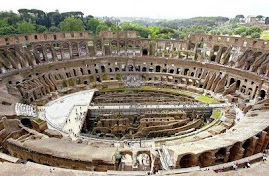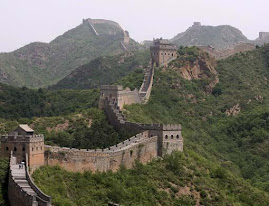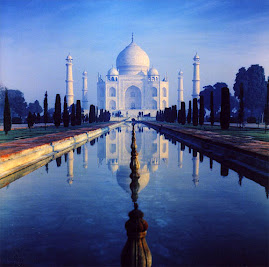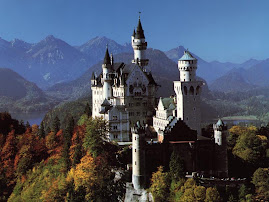The Beginning of The Great Wall

The construction of the wall began during the Warring States Period from the 8th century BC to 221 BC, the states of Qi, Yan and Zhao all constructed extensive fortifications to defend their own borders. Built to withstand the attack of small arms such as swords and spears, these walls were made mostly by stamping earth and gravel between board frames. The Great Wall is a fortification along the northern and northwestern frontier of China, running from Shanhaiguan on the Gulf of Bohai on the east to the vicinity of Gaodai, Gansu Province, on the west, with an inner wall running southward from the vicinity of Beijing almost to Handan. Shi Huangdi, first emperor of the Chin dynasty erected the largest portion of the wall as a defense against raids by nomadic peoples. Systematic work on the wall was begun about 221 BC, after Shi Huangdi had united China under his rule, and it was finished about 204 BC. Small sections of the wall were probably already in existence, but Shi Huangdi is supposed to have had some nearly 1,200 miles of the wall erected during his reign.

300,000 men --- many of them political prisoners whose bodies are rumored to be buried in the wall (not actually true) --- were put to work connecting the segments into one huge rampart of stone and earth. In succeeding centuries, chiefly during the period of the Ming dynasty (AD 1368-1644), the Great Wall was repaired and extended by reinforcing it with cement and stone. The fortification finally reached a length of about 1,500 miles, following the course of rivers instead of bridging them and conforming to the contours of the mountains and valleys in its path. The wall is built of earth and stone, faced with brick in the eastern parts. It is from 15 to 30 feet thick at the base (about 20 feet on the average) and tapers to some 12 feet at the top. The height averages 25 feet exclusive of the crenellated parapets. Watchtowers about 40 feet in height are placed at intervals of approximately 200 yards. Several hundred kilometers of the Great Wall remain intact in the eastern reaches.
The amount of brick and stone employed to construct the Great Wall could circumscribe the earth with a dike eight feet high. From the 6th to the 14th centuries, the wall ceased to be an effective barrier against determined invaders, who discovered that bribing the sentries was their most effective weapon. The Chinese Emperors helped in this cause by failing to pay their army troops, generally a bad mistake. If you don't pay your army,
The amount of brick and stone employed to construct the Great Wall could circumscribe the earth with a dike eight feet high. From the 6th to the 14th centuries, the wall ceased to be an effective barrier against determined invaders, who discovered that bribing the sentries was their most effective weapon. The Chinese Emperors helped in this cause by failing to pay their army troops, generally a bad mistake. If you don't pay your army,
Extent of The Great Wall

Scholars estimate that the Great Wall with all its branches once stretched for 6,200 miles, from the Yalu River in the northeast to Xinjiang in the northwest. Today it measures 6,000 miles. The Great Wall has suffered serious damage from wind and water erosion, as well as man-made destruction. In the past it has been a treasure store of stone for many a poor farmer. Between 1870 and 1974, the 8th Route Army stationed at Gubeikou destroyed 9,840 feet of the wall to use the stone to erect some barracks. Later in 1979, the State ordered the same army group to tear down their barracks and rebuild the wall.
Secrets of the Great Wall

In 226 the armies of the Chu Dynasty and the Qin dynasty met in a great final battle. The victor would get the prize of the richest and most technologically advanced nation of the world. The Qin Emperor needed to defend the country from the marauding bands of nomadic horsemen of the north. These bands of horsemen who raided the rich farmland came from the barren land of the north and were forced to become marauding nomads. It was a clash of farmers against warriors. The group would be difficult to defeat. The strength, stability and prosperity of the new empire were threatened by these marauding hordes.
To preserve China's borders the Qin set about building a huge defensive barrier in 221 BC. Wall building became the chief defensive strategy to repel the enemy from the north. This was in the age before gunpowder and cannons. The first Great Wall was a massive undertaking. It was the equivalent of building 30 of the great pyramids of Egypt. To build this great wall of 3,000 miles the Qin Emperor chose his most able general Ling Qia. He was given an army of over 300,000 men.

They had to build roads, and the infrastructure as well as the wall. Much of the wall was built of beaten clay. Stone was not always available, so tamped earth became the first choice. Soil was selected from at least four inches below the surface so seeds and grasses could not germinate and thus undermine the strength of the wall. Using first a form made of wood, earth was piled and was pounded into a layer of four inches thick. Successive layers of this would produce a wall twenty feet high that would still be standing some 2,000 years later.

The wall stretched from the borders of North Korea across the northern border to the far reaches in western China. In ten years they built a wall across the entire northern border of China in lands that included marshes, quicksand, deserts, and altitudes of 8,000 feet. They built twenty-five miles a month that is almost a mile a day. One section is across 60 miles of a mountain range. This section was built entirely of native stone with the flat face placed on the outside to face the enemy. This dry stonewall was built 20 feet high with 26-foot high beacon towers.
Defense of The Great Wall

The Qin army invented new weapons to exploit their advantage of their new wall. The most deadly of these was the crossbow that could hurl an arrow 250 yards with amazing accuracy. Other weapons included iron casting techniques to produce double edged swords which would not be known in the west for some 1,300 years later. The soft bronze swords of the enemy were no match for the double-edged iron swords of the Qin army.

All of this was achieved at great economic and human costs. The emperor thought the wall would bring peace to the nation but the nation was weakened by the heavy cost of the construction. Ditches along the wall were filled with the corpses of workers who died building the wall. Deaths of wall workers are estimated to exceed one million. Some have claimed that the dead workers were entombed in the wall itself. Later investigations proved this untrue. Also decaying bodies would have weakened the structure and would not have been allowed.
The Cost of The Great Wall

No society could sustain such a terrible burden. Taxation became heavier and heavier. Some 3,500,000 people were involved in the building of the Great Wall. That was 70% of the total population of China at that time. For each worker working on the wall, six were required to feed and support them. Construction of the Qin wall became the most hated imperial project in Chinese history.
In 209 BC, only a year after the death of the Qin Emperor, millions of peasants rose up and ended the tyranny and bloodshed of wall building. The Qin Dynasty had fallen, brought down by the building of the great wall. Within ten years much of the wall was a neglected ruin. Once again the northern border was at the mercy of the northern invaders.
The Han Dynasty Extends of The Great Wall

After three years of civil war in 206 BC the first Han Dynasty was formed under the Gao Di Emperor, Liu Bang. At first he attempted to appease the northern invaders with gifts and increased trade but peace was sporadic. A massive force of the Han army attacked the invaders and forced them back across the northern borders.
To consolidate their victories they began to mark out their new extended borders. In many areas they simply restored the old Qin wall. In order to build walls in the desert of the west, new methods of construction had to be devised. Here the soil consists of a gravel of sand and small stones. They used alternating layers of red willows and the gravel and lots of tamping. This produced a wall that has survived for some 2,000 years.

Using these techniques and hundreds of thousands of people, the Han were able to build the wall far into the Gobi desert. And where clay was used as a skin or coating it made the wall difficult to scale and protected it against the erosion of the weather. The Han leadership knew to have a strong frontier they not only needed to build a strong wall but they also needed crack troops to defend it.
They developed a force of light cavalry that could foray into the enemy territory to check on the enemy movements in his own grounds. They had many victories against the Xiongnu. They then employed renegade Xiongnu horse masters to set up horse breeding stables and to train their troops in horsemanship. By the time of the sixth Han Emperor Wu Di some 66 years later, they had crushed the Xiongnu and the wall was extended some 300 miles into the Gobi Desert.
They developed a force of light cavalry that could foray into the enemy territory to check on the enemy movements in his own grounds. They had many victories against the Xiongnu. They then employed renegade Xiongnu horse masters to set up horse breeding stables and to train their troops in horsemanship. By the time of the sixth Han Emperor Wu Di some 66 years later, they had crushed the Xiongnu and the wall was extended some 300 miles into the Gobi Desert.
The Changes of The Great Wall
The wall now extended across the principle trading routes and if you wished to trade with the Chinese you needed to enter through the gates in the wall. Around these gates towns were established and became the trade centers of the area. At most gates foreigners were not allowed to go past the gates so these became the portals of trade into China.
One perfect example is the beautifully preserved Jade Gate. Built in 101 BC, it is 28 feet high and 66 feet square. Close by they built a fort for the Han soldiers guarding the wall. This section of the wall is 453 feet long, 115 feet wide and 23 feet high.
The wall became more than a trade route and a barrier to keep out the enemy, it became vital for communications. Along its ramparts messages could be sent at amazing speeds from one end of the empire to the other. All along the northern border beacon towers were built every 15 to 30 miles. They formed a communication network, which ran from outposts deep into enemy territory to the ancient capital in the east.
The wall became more than a trade route and a barrier to keep out the enemy, it became vital for communications. Along its ramparts messages could be sent at amazing speeds from one end of the empire to the other. All along the northern border beacon towers were built every 15 to 30 miles. They formed a communication network, which ran from outposts deep into enemy territory to the ancient capital in the east.
From these towers the Han troops used smoke by day and torches by night to send messages along the length of the wall. They burnt wood, and straw mixed with wolf dung, which produced rich black columns of smoke. Statutes strictly governed the code of these signals. One column of smoke indicated an impending attack by a force of less than 500. Two columns indicated an attack by a force less than 3,000 and four columns indicated an attack by a force of up to 10,000.
The Ming Dynasty Changes The Great Wall

China would wait another 1,300 years before embarking on its greatest period of wall building. The Ming Dynasty built much of what remains today. They were driven by desperation to build the ultimate defense and lock the northern frontier once and for all. The Ming renovated the old Qin and Han walls and extended them. The Ming wall stretched some 4,500 miles from the Korean border at Dandong to the city of Jayuguan in the western desert. Today that fort is one of the most impressive, ornate, and sophisticated military constructions in the history of China.
The Ming Dynasty came into power in 1368 inheriting a nation crushed by 100 years of rule by the Mongols. The mighty Genghis Khan had united these tribes in 1206 and had pushed their way through China. Ultimately they fell from within. A peasant revolt spelled the defeat of the Mongol empire.
The leader of this revolt was Zhu Yangzhong who was installed as the first Ming Emperor. He immediately took up the challenge to begin building the great defense again. The enthusiasm in which the Ming emperors embraced this ambition was staggering. They built more wall than any other dynasty. The Ming wall was typically built with a stone facing over tamped inner clay. This wall was almost indestructible. 

The Ming bricks were a marvel of engineering holding up to a pressure of over 1000 pounds per square inch. The mortar was of super strength. The mortar was stronger than the bricks themselves. The puzzle of this super strength has now been solved. The mystery ingredient was rice flour. With innovations like these, the Ming was able to build spectacular monuments. A feature of the wall was water drainage systems that channeled the water to the Chinese side and withheld the water to the enemy side and thus inhibited plant growth and so denied cover to the attackers.
Warning towers were built in enemy territory. These spurs were built out from the main wall and permitted the Chinese to attack the marauders from two sides. The armies were controlled from watchtowers that were built every 200 yards along the Ming walls. Locks and bolts secured the doors and windows from within creating a formidable fortress. From these towers the defenders could unleash arrows and spears from heavily protected slits. Later cannon were used. Having discovered gunpowder, the Ming was also the first to use hand grenades and mines. Stones were also pushed through special openings to create manmade avalanches to crush the enemy.
If the attackers succeeded in scaling the wall, the defenders could retreat to the guard towers. These guard towers were only accessible by retractable ladders.














No comments:
Post a Comment